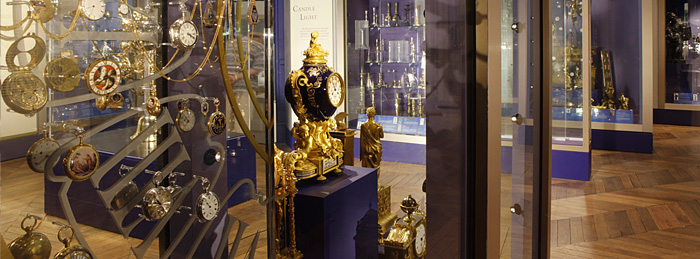The Bowes Museum Blog

Watching the Clock: Timekeeping at The Bowes Museum


Josephine Bowes was a chameleon throughout her life and transformed herself into an actress, an artist, a society hostess and a major collector. She began as the daughter of a Parisian clockmaker, and it is this start in life that must have given her a lifelong affection for the art which has led to the collection of timepieces we have in the gallery today.
Alongside her husband, John Bowes, Josephine collected extensively, with a wide field of interest. When they first conceived of building a museum together, John and Josephine had contemplated acquiring objects from all over the world. Eventually they reconsidered and reduced their ambitions to covering Europe. Every country that formed Europe in 1870 is represented in the Museum’s collection.
The timepieces in the Silver and Metals gallery come from England, France, Germany and Italy. France in particular was considered an important pioneer in the art of clock-making. As expertise in clock-making developed, watch makers became increasingly elaborate in their designs. Clocks were admired as much as any furniture piece in the decorative arts and they were an integral part of domestic furnishing from the 17th century. The evolving complexity of the inner mechanism was equally matched by clocks’ development as decorative objects.
Clocks for the mantelpiece and for tables are designed to stay in place, so do not have carrying handles and are often very heavy. The movements in some early table clocks were even made from iron. Timepieces that took pride of place in the home and were not moved were ornate and often extravagant in their design. The cases are made from decorative castings, gilding and engraving. Their popularity reflected the increasing demand for clocks as permanent room furnishings in the nineteenth century.
The clock below demonstrates the craftsmanship invested in table clocks for the home. It features twelve different musical tunes and can be set to ‘strike’, or ‘silent’. By turning a dial, one of the twelve tunes will play after the striking of the hour. Resting on silver mounts, the oak case is topped with a silver bust and finely worked metal, with elegant, swirling patterns as a backdrop to the clock face.

John Newton Table Clock, c.1754, London, silver mounts by John Pollock.
Presented by Mr. Roland Cook through The Art Fund, in memory of Mrs Cookson. 1980.14.1/CW.
Elaborate and beautiful design was not left just to the dramatic mantelpiece clocks that took centre stage in the home. Small timepieces such as pocket watches became more intricate in their design and technology advanced. Technical advances meant that watch movements could retain their accuracy while being reduced in size and designed to be worn on the move.
A vast variety of styles were available. One of the most unusual pieces in The Bowes Museum’s collection is a silver watch in the shape of a skull. It was made by the renowned French watch maker Le Roy et Fil, between 1755 and 1765. Napoleon Bonaparte was known to have favoured the expertise and fine pieces of Le Roy et Fil. This may have sparked John Bowes’ curiosity in the watch as he had a strong interest in the life of Napoleon.

Watch in the form of a skull, Le Roy et Fil, c.1755-1765, CW.52.
The skull is split in half horizontally, along the centre of the eyes. The hinge is at the back of the skull. When the top of the skull is lifted open, it reveals a detailed watch face inside. There are two dials, one inside the other. The inner dinner contains the hours marked in roman numerals and the outer dial displays the minutes.

Interior of Watch in the form of a Skull, Le Roy et Fil.
Although the watchmakers also had a London shop, it is known that this piece was manufactured in Paris from its stamp. Care was taken in the most minute of details, even the manufacturer’s name is inscribed in script on the back plate along with the place of manufacture
The watchmakers survived the turmoil of the French Revolution and went on to become a hugely successful company, expanding distribution and clientele as far afield as Buenos Aires. The founders of Le Roy Et Fil were among the most conceptually avant-garde of their time and invented many new mechanisms.
Current watch brands continue to push technological boundaries. Complications on watch movements allow us to use our watches during extreme sports, satellite technology allows us to travel through time zones without adjusting our time piece and smart watches let us read messages without looking at a phone. But, do our modern time pieces have the edge on aesthetic design?
By Caroline Potts, Curatorial Intern




